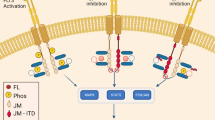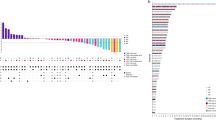Abstract
Philadelphia chromosome-associated leukemias are among the most well-understood human malignancies. The importance of BCR-ABL enzymatic activity in the proliferation of the leukemic clone has been confirmed by the high response rates of these leukemias to the ABL-selective tyrosine kinase inhibitor STI571, even in advanced disease phases, which are characterized by increased genetic heterogeneity. Disease relapse has been observed in a subset of patients who had initially responded to STI571. Evidence suggests that BCR-ABL activity is restored in the majority of these cases of acquired resistance. Molecular studies of resistant leukemia cells isolated from patients have implicated BCR-ABL kinase domain point mutation as the most common mechanism of resistance. Additionally, genomic amplification of the BCR-ABL gene can occasionally be detected. This review will highlight mechanisms of STI571 resistance in clinical samples as well as preclinical models.
This is a preview of subscription content, access via your institution
Access options
Subscribe to this journal
Receive 50 print issues and online access
$259.00 per year
only $5.18 per issue
Buy this article
- Purchase on Springer Link
- Instant access to full article PDF
Prices may be subject to local taxes which are calculated during checkout



Similar content being viewed by others
References
Barthe C, Cony-Makhoul P, Melo JV and Mahon JR . (2001). Science, 293, 2163.
Deininger MW, Goldman JM, Lydon N and Melo JV . (1997). Blood, 90, 3691–3698.
Druker BJ, Talpaz M, Resta DJ, Peng B, Buchdunger E, Ford JM, Lydon NB, Kantarjian H, Capdeville R, Ohno-Jones S and Sawyers CL . (2001). N. Engl. J. Med., 344, 1031–1037.
Druker BJ, Tamura S, Buchdunger E, Ohno S, Segal GM, Fanning S, Zimmermann J and Lydon NB . (1996). Nat. Med., 2, 561–566.
Gambacorti-Passerini C, Barni R, le Coutre P, Zucchetti M, Cabrita G, Cleris L, Rossi F, Gianazza E, Brueggen J, Cozens R, Pioltelli P, Pogliani E, Corneo G, Formelli F and D'Incalci M . (2000). J. Natl. Cancer Inst., 92, 1641–1650.
Gambacorti-Passerini C, le Coutre P, Mologni L, Fanelli M, Bertazzoli C, Marchesi E, Di Nicola M, Biondi A, Corneo GM, Belotti D, Pogliani E and Lydon NB . (1997). Blood Cells Mol. Dis., 23, 380–394.
Gorre ME, Mohammed M, Ellwood K, Hsu N, Paquette R, Rao PN and Sawyers CL . (2001). Science, 293, 876–880.
Graeber T, Nicoll JM, Shah NP, Paquette RL and Sawyers CL (submitted).
Hochhaus A, Kreil S, Corbin A, La Rosee P, Lahaye T, Berger U, Cross NC, Linkesch W, Druker BJ, Hehlmann R, Gambacorti-Passerini C, Corneo G and D'Incalci M . (2001). Science, 293, 2163.
Hochhaus A, Kreil S, Corbin A, La Rosee P, Muller M, Lahaye T, Hanfstein B, Schoch C, Cross NCP, Berger U, Gschaidmeier H, Druker BJ and Hehlmann R . (2002). Leukemia, 16, 2190–2196.
Hofmann WK, Jones LC, Lemp NA, de Vos S, Gschaidmeier H, Hoelzer D, Ottmann OG and Koeffler HP . (2002). Blood, 99, 1860–1862.
Jorgensen HG, Elliott MA, Allan EK, Carr CE, Holyoake TL and Smith KD . (2002). Blood, 99, 713–715.
Kantarjian H, Sawyers C, Hochhaus A, Guilhot F, Schiffer C, Gambacorti-Passerini C, Niederwieser D, Resta D, Capdeville R, Zoellner U, Talpaz M and Druker B . (2002). N. Engl. J. Med., 346, 645–652.
le Coutre P, Tassi E, Varella-Garcia M, Barni R, Mologni L, Cabrita G, Marchesi E, Supino R and Gambacorti-Passerini C . (2000). Blood, 95, 1758–1766.
Mahon FX, Deininger MW, Schultheis B, Chabrol J, Reiffers J, Goldman JM and Melo JV . (2000). Blood, 96, 1070–1079.
Nagar B, Bornmann W, Pellicena P, Schindler T, Veach D, Miller WT, Clarkson B and Kuriyan J . (2002). Cancer Res., 62, 4236–4243.
Nowell PC and Hungerford DA . (1960). Science, 132, 1497–1501.
Ricci C, Scappini B, Divoky V, Gatto S, Onida F, Verstovsek S, Kantarjian HM and Beran M . (2002). Cancer Res., 62, 5995–5998.
Roche-Lestienne C, Soenen-Cornu V, Grardel-Duflos N, Lai JL, Philippe N, Facon T, Fenaux P and Preudhomme C . (2002). Blood, 100, 1014–1018.
Rowley JD . (1973). Nature, 243, 290–293.
Sawyers CL, Hochhaus A, Feldman E, Goldman JM, Miller CB, Ottmann OG, Schiffer CA, Talpaz M, Guilhot F, Deininger MW, Fischer T, O'Brien SG, Stone RM, Gambacorti-Passerini CB, Russell NH, Reiffers JJ, Shea TC, Chapuis B, Coutre S, Tura S, Morra E, Larson RA, Saven A, Peschel C, Gratwohl A, Mandelli F, Ben-Am M, Gathmann I, Capdeville R, Paquette RL and Druker BJ . (2002). Blood, 99, 3530–3539.
Schindler T, Bornmann W, Pellicena P, Miller WT, Clarkson B and Kuriyan J . (2000). Science, 289, 1938–1942.
Shah NP, Nicoll JM, Nagar B, Gorre ME, Paquette RL, Kuriyan J and Sawyers CL . (2002). Cancer Cell, 2, 117–125.
Weisberg E and Griffin JD . (2000). Blood, 95, 3498–3505.
Acknowledgements
We thank Phuong Huynh for assistance with manuscript preparation. NPS and CLS are supported by awards from the Leukemia and Lymphoma Society. CLS is a Doris Duke Distinguished Clinical Scientist.
Author information
Authors and Affiliations
Corresponding author
Rights and permissions
About this article
Cite this article
Shah, N., Sawyers, C. Mechanisms of resistance to STI571 in Philadelphia chromosome-associated leukemias. Oncogene 22, 7389–7395 (2003). https://doi.org/10.1038/sj.onc.1206942
Published:
Issue Date:
DOI: https://doi.org/10.1038/sj.onc.1206942
Keywords
This article is cited by
-
Current Approaches to Philadelphia Chromosome–Positive B-Cell Lineage Acute Lymphoblastic Leukemia: Role of Tyrosine Kinase Inhibitor and Stem Cell Transplant
Current Oncology Reports (2021)
-
Molecular Mechanisms of Resistance to Tyrosine Kinase Inhibitors
Current Hematologic Malignancy Reports (2019)
-
A river model to map convergent cancer evolution and guide therapy in RCC
Nature Reviews Urology (2015)



